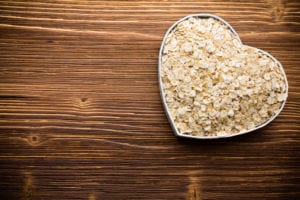Written by Greg Arnold, DC, CSCS. College females who supplemented with a prebiotic fiber such as inulin-type fructans, for seven days experienced significant reduction in appetite, hunger, satiety, and food consumption and had no weight gain compared to the control group.
 Many studies have shown the benefit of increased fiber intake on health such as weight regulation 1, increased feelings of fullness 2 and reduced calorie intake. 3 While research has focused mainly on soluble fibers such as in fruits and insoluble fibers as found in cereals, another type of fiber is garnering attention; namely fermentable fiber, specifically inulin-type fructans. Inulin-type fructans (ITFs), classified as practical nutritional supplements, are easily digestible prebiotics that support the growth of healthy bacteria such as bifidobacteria, thereby increasing the production of short-chain fatty acids (SCFAs). 4
Many studies have shown the benefit of increased fiber intake on health such as weight regulation 1, increased feelings of fullness 2 and reduced calorie intake. 3 While research has focused mainly on soluble fibers such as in fruits and insoluble fibers as found in cereals, another type of fiber is garnering attention; namely fermentable fiber, specifically inulin-type fructans. Inulin-type fructans (ITFs), classified as practical nutritional supplements, are easily digestible prebiotics that support the growth of healthy bacteria such as bifidobacteria, thereby increasing the production of short-chain fatty acids (SCFAs). 4
Studies have shown that consuming fermentable fibers such as ITFs can reduce levels of ghrelin, a hormone that enhances appetite and leads to increased food intake.5 To provide further clarification of the potential impact of ITF fiber on appetite researchers conducted the following randomized, double-blind, placebo-controlled short intervention study.6 Forty college females, between the ages of 18 and 25, supplemented their breakfasts for seven days with either a fiber drink containing16 grams of ITFs in 330 ml of artificially flavored water (n=20) or a placebo consisting of artificially flavored water, without added fiber, in an identical opaque bottle (n = 20) . Every day during the study and at different time intervals between breakfast and lunch, all participants answered questions pertaining to their appetite.
On each study day participants were given a breakfast consisting of 60 grams of cereal (225 calories) and 180 milliliters of 2% milk (72 calories), and a lunch consisting of a chicken breast sandwich (425 grams) with 25 grams of chips (134 calories) and 300 mL of orange juice (150 calories). Food and drinks were weighed separately, pre- and post-meal, to determine energy consumption. Repeated measures ANOVA was used to compare Visual analogue scale (VAS) ratings on test day and paired t-tests to compare energy consumption. Following completion of the seven fast days, researchers noted a significant benefit to hunger control in the fiber group:
- While the fiber group reported 44% higher feeling of ‘fullness’ at 95 min (65 vs 45 on the visual analog scale, p = 0.037) and 59% higher ‘fullness’ at 155 min after breakfast (51 vs 32 on the VAS, p = 0.021), the control group had a100% higher ‘desire to eat’ 50 minutes after breakfast (30 vs 15 on the VAS, p = 0.05), 95% higher ’desire to eat’ at 95 minutes after breakfast (43 vs 22 on the VAS, p = 0.007)
- The control group also reported 100% higher ‘hunger’ ratings 20 min (28 vs 14 on the VAS, p = 0.044) and 60% higher ‘hunger’ ratings 50 minutes after breakfast (40 vs 25 on the VAS, p = 0.042).
- The fiber group consumed significantly less energy from foods consumed at lunch compared to the control group (453+ 47 kcal vs 571+ 39Kcal, p=0.031)
- The control group gained significant weight at the end of the study compared to its baseline weight (p=0.037) while the fiber group had no significant weight increase
A limitation of the study was the potential impact that menstrual cycles have on appetite hormones and weight fluctuations. 7 Furthermore study participants were college-aged females, aged 18 – 25 years; therefore, results may not be generalizable. However, the authors concluded that 16g/day of fiber did reduce hunger, appetite and food consumption and increased satiety, and suggested that “ITF fiber is potentially a useful adjunct dietary supplement for curbing appetite and possibly aiding weight management” and that future studies should explore inulin-type fructans’ long term benefits.
Source: Salmean, Younis A. “Acute fiber supplementation with inulin-type fructans curbs appetite sensations: a randomized, double-blind, placebo-controlled study.” Food & nutrition research 61, no. 1 (2017): 1341808.
© 2017 The Author(s). Published by Informa UK Limited, trading as Taylor & Francis Group. Creative Commons Attribution License (http://creativecommons.org/licenses/by/4.0/)
Click here to read the full text study.
Posted November 27, 2017.
References:
- Slavin JL. Dietary fiber and body weight. Nutrition. 2005;21(3):411-418.
- Hull S, Re R, Tiihonen K, Viscione L, Wickham M. Consuming polydextrose in a mid-morning snack increases acute satiety measurements and reduces subsequent energy intake at lunch in healthy human subjects. Appetite. 2012;59(3):706-712.
- Pelkman CL, Navia JL, Miller AE, Pohle RJ. Novel calcium-gelled, alginate-pectin beverage reduced energy intake in nondieting overweight and obese women: interactions with dietary restraint status. The American journal of clinical nutrition. 2007;86(6):1595-1602.
- Kleessen B, Hartmann L, Blaut M. Oligofructose and long-chain inulin: influence on the gut microbial ecology of rats associated with a human faecal flora. British Journal of Nutrition. 2001;86(2):291-300.
- Wren A, Seal L, Cohen M, et al. Ghrelin enhances appetite and increases food intake in humans. 2001.
- Salmean YA. Acute fiber supplementation with inulin-type fructans curbs appetite sensations: a randomized, double-blind, placebo-controlled study. Food & nutrition research. 2017;61(1):1341808.
- Sramkova M, Duskova M, Vitku J, et al. Levels of adipokines and some steroids during the menstrual cycle. Physiological research. 2015;64:S147.

